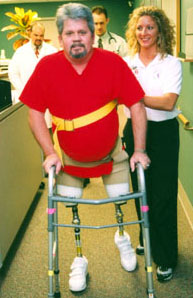FLOWOOD, Miss.—After Curtis Green of Pearl lost both legs below the thigh to complications from blood clots and infection, his life became a whirlwind of doctor’s visits, therapy appointments and prostheses fittings.
So he was delighted to discover Methodist Rehabilitation Center’s new monthly clinic for people who use prostheses. There he can see a physician, physical therapist and prosthetist all at the same time. “It’s a great convenience,” Green said.
It’s also an effective way to coordinate care, said Chris Wallace, a certified orthotist/prosthetist and director of the hospital’s Orthotics and Prosthetics division.
“In the past, a patient would go to a surgeon, then be referred to a rehabilitation doctor or prosthetic facility for fabrication of the limb. And it would be hit or miss whether the patient was referred to therapy or whether or not a physician was controlling the direction of the rehabilitation team,” Wallace said. “In contrast, our clinic is a collaborative effort. The physical therapist and the prosthetist begin the evaluation process. They present the information to the physician, and he takes over from there. We all have input.”
During Green’s appointment on a recent Wednesday afternoon, the team watched closely as he navigated the hall on his new prosthetic legs. Physical therapist Latisha Clinton had her eye on Green’s gait, while Wallace and Jennifer Long, a certified prosthetist/orthotist, judged the fit and function of Green’s prostheses.
Physical medicine physician James Williams was on hand to gauge Green’s medical condition and is ultimately responsible for directing physical therapy and the prosthetic prescription.
“I look at the patients from a physical standpoint and adjust the prosthesis or the therapy orders based on their medical condition,” Dr. Williams said. “For example, when people have congestive heart failure, it can lead to limb swelling and affect the fit of the prosthesis. I recognize those things and adjust the prosthesis prescription accordingly. And I make sure the therapy prescribed is as safe as possible given the patient’s medical condition.”
Clinton said the role of physical therapy is to help Green physically adjust to his new legs. “With people who have new prostheses, we work a lot on gait training, strength and conditioning, range of motion, balance and accessibility in the home and community,” she said. Physical therapists also work closely with the prosthetists to share insight on how the patient’s prosthesis is fitting and to collaborate on any needed modifications.
Green said he appreciated the team’s diligence because he has set some lofty goals for himself. “I’m going to amaze them,” he said. “To me it’s a challenge and I haven’t ever backed down from a challenge. Whatever the team expects of me, I’ll expect more. I want to be able to get up and around. I’ve already sat in a wheelchair longer than I wanted to.”
Clinton said Green’s progress so far “has blown us away.”
“Not that many double, above-the-knee amputees attempt to walk because of the enormous energy expenditure required to do so,” said Susan Hoxie, who is Green’s principal physical therapist at Methodist Rehab.
And those that do attempt the challenge typically make the transition in stages, said Methodist Rehab certified prosthetist Darby Shook. At first, they use a prosthesis without a knee joint—basically a socket bolted directly to a foot. Then they graduate to a full prosthetic leg.
But Shook said that Green was in such good shape and wanted so desperately to walk that he skipped the first step.
“His approach was: Why not go for it,” Hoxie said. “And that has been his approach throughout therapy. He’s a go-getter.”
“When we would tell him something might be difficult for him, he would accomplish it to prove us wrong – which is great,” said Brad Kennedy, another of Green’s prosthetist and an above-the-knee amputee himself.
Similar successes would likely be within reach for more patients if they had the benefit of a highly collaborative approach to their care, Wallace said. “Sometimes people get lost in the cracks and their needs are not addressed because of lack of communication,” he said. “We’re hoping our clinic will become a referral avenue for general surgeons or other physicians who would like a positive choice in the management of prosthetic patients through the rehabilitation process. With our team approach, physicians can be confident their patients are being well cared for.”
Methodist Rehabilitation Center’s amputee clinic meets once a month at the hospital’s East Campus in Flowood. For information on the clinic, call 601-936-8899 or go to methodistonline.org.

